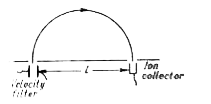The electron beam in the device shown in Fig. 28.7a is deflected upwards by a transverse magnetic field. The field is effective along a length l= 20 mm, the distance of the deflection system from the screen being L =175 mm. The magnetic induction is 10−3T, the anode voltage is 500 V. Find the deflection of the electron beam on the screen. 
The correct Answer is:51mm.
The electrons in this problem are nonrelativistic, they enter the magnetic field at a speed u=√2eΨ/m=1.33×107m/s. In the magnetic field they move along an arc of a circle of radius R=um/eB (Fig 28.7b). The electrons are deflected through an anle ∠GCE=α. But the angle ∠GCE is congruent to the angle ∠COM (as angles with mutually perpendicular sides). Therefore sinα=MCOC=lR=eBlmeu=eBl√2meeΨ
As is evident from the figure, GD=GE+EB, or
d=Ltanα+R(1−cosα)=Ltanα+l1−cosαsinα=Ltanα+ltanπ2
Knowing the parameters of the device one may easily calculate the displacement sought. 
Similar Questions
An electron beam projected along positive x-axis deflects along the positive y-axis. If this deflection is caused by a magnetic field, what is the direction of the field?
View SolutionAn electron beam projected along positive x-axis deflects along the positive y-axis. If this deflection is caused by a magnetic field, what is the direction of the field?
View Solution
Knowledge Check
Two electrons Beams having velocities in the ratio1:2 are subjected to the same transverse magnetic field . The ratio of the deflections is
A1:2B2:1C4:1D1:4Following experiment was performed by J.J. Thomson in order to measure ratio of charge e and mass m of electron.

Electrons emitted from a hot filament are accelerated by a potential difference V. As the electrons pass through deflecting plates, they encounter both electric and magnetic fields. the entire region in which electrons leave the plates they enters a field free region that extends to fluorescent screen. The entire region in which electrons travel is evacuated.
Firstly, electric and magnetic fields were made zero and position of undeflected electron beam on the screen was noted. The electric field was turned on and resulting deflection was noted. Deflection is given by d1=eEL22mV2 where L = length of deflecting plate and v = speed of electron.
In second part of experiment, magnetic field was adjusted so as to exactly cancel the electric force leaving the electron beam undeflected. This gives eE=evB. Using expression for d1 we can find out em=2d1EB2L2
A beam of electron with velocity 3×107ms−1 is deflected 2 mm while passing through 10 cm in an electric field of 1800V/m perpendicular to its path. e/m for electron isA1.5×1011Ckg−1B2×1011Ckg−1C2.5×1011Ckg−1D3×1011Ckg−1
An electron is projected into a magnetic field of B= 5×10−3 T and rotates in a circle of radius of R=3 mm. Find the work done by the force due to magnetic field.
View SolutionA narrow stream of vanadium atoms in the ground state .4F3/2 is passed through a transverse strongly inhomogeneous magnetic field of lengthl1=5.0cm as in the Stern-Gerlach experiment. The beam splitting is observed on a screen located at a distance l2=15cm from the magnet. The kinetic energy of the atoms is T=22meV. At what value of the gradient of the magnetic field induction B is the distance between the extreme components of the split beam in the screen equal to δ=2.0mm ?
View SolutionA stream of electrons moving with a velocity of 3×107ms−1 is deflected by 2 mm in traversing a distance of 0.1 m in a uniform electric field of strength 18Vm−1 in Fig. 1.42. An electron enters the field symmetrically between the plates with a speed υ0. The length of each plate is l. Find the angle of deviation of the bath of the electron as it comes out of the field.
View SolutionIn the Bainbridge mass spectrometer (Fig. 28.13) the distance between the velocity filter (selector) exit and the entrance slit of the detecting device (collector slit) is fixed and equal to l= 400 mm. The magnetic induction in both sections of the device is the same, being equal to 5.00×10−2T. When the electric field in the velocity filter
 is varied continuously the anode current peaks are observed at field strengths of 1.20×104 V/m and 1.60×104V/m. Assuming the ions to be singly charged, identify them (i.e. find the element to which they belong).
is varied continuously the anode current peaks are observed at field strengths of 1.20×104 V/m and 1.60×104V/m. Assuming the ions to be singly charged, identify them (i.e. find the element to which they belong).
View SolutionIn a cathode ray tube the length of deflection plates is 78mm and their separation is 0.24m, while the distance form the centre orf the plate to the screen is 0.33m. No deflection of the electron beam is observed when the potential difference is 2800V and the magnitude field is 8.2×10−4Wbm−2. When only the magnetic field is applied, deflection on the screen is 28mm. Find e/m.
View SolutionFollowing experiment was performed by J.J. Thomson in order to measure ratio of charge e and mass m of electron.

Electrons emitted from a hot filament are accelerated by a potential difference V. As the electrons pass through deflecting plates, they encounter both electric and magnetic fields. the entire region in which electrons leave the plates they enters a field free region that extends to fluorescent screen. The entire region in which electrons travel is evacuated.
Firstly, electric and magnetic fields were made zero and position of undeflected electron beam on the screen was noted. The electric field was turned on and resulting deflection was noted. Deflection is given by d1=eEL22mV2 where L = length of deflecting plate and v = speed of electron.
In second part of experiment, magnetic field was adjusted so as to exactly cancel the electric force leaving the electron beam undeflected. This gives eE=evB. Using expression for d1 we can find out em=2d1EB2L2
A beam of electron with velocity 3×107ms−1 is deflected 2 mm while passing through 10 cm in an electric field of 1800V/m perpendicular to its path. e/m for electron is
View Solution
